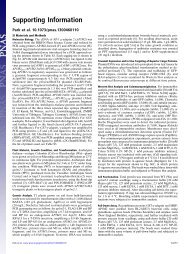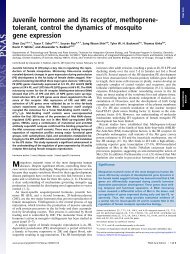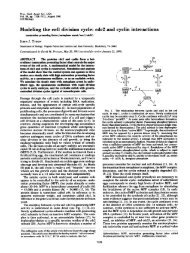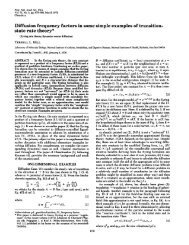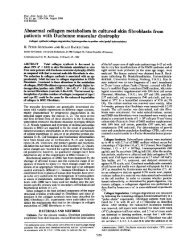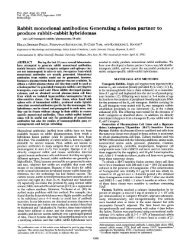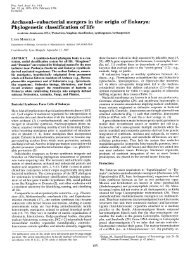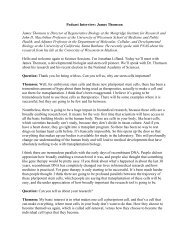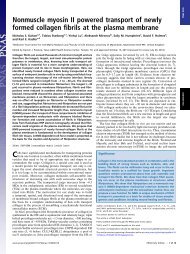View Transcript
View Transcript
View Transcript
Create successful ePaper yourself
Turn your PDF publications into a flip-book with our unique Google optimized e-Paper software.
Podcast interview: Nate Lewis<br />
Welcome to Science Sessions. I’m Jenny Morber.<br />
JM: Among our five senses, our ability to smell is often considered as relatively<br />
unimportant. Perhaps this is why scientists still don’t fully understand how human<br />
olfaction works. Or perhaps the mystery is due to the sheer complexity of smell. The<br />
odor of roasted coffee, for example, is made up of over 670 compounds, and the human<br />
nose can distinguish approximately 10,000 odors. Current research suggests that rather<br />
than using specific receptors for every odor, human smell relies on recognizing patterns<br />
of interactions between receptors and an odor’s many compounds. This pattern is sent<br />
to the brain where it matches up to a memory: ah…roasted coffee! For over two decades,<br />
professor and researcher Nate Lewis has been working to develop an electronic sensor<br />
that mimics this complex chemical recognition–an electronic nose.<br />
NL: The mammalian olfactory system does not have a specific receptor for every analyte<br />
that it is intended to detect. When you present your odor on a handkerchief to a dog,<br />
and then they can trace you versus me, they don’t have any Jenny receptors or Nate<br />
Lewis receptors: yet they can do it out of any one of the 200,000,000 people in the<br />
country. So they must do that by pattern recognition.<br />
NL: A specific odor receptor responds to many different odorants, and in turn any<br />
specific odorant elicits a response from many different odor receptors. So, the idea is to<br />
copy that architecture. This pattern is preferable to that pattern. This off-odor in<br />
packaging is unacceptable because there should be no odor. You trade our ability to<br />
make specific odor selectors for instead signal processing on the backend. Signal<br />
processing is very powerful and very cheap. And that’s what the electronic, artificial<br />
noses are best mated towards.<br />
JM: But most of us have noses that work just fine and come well, mostly free. Couldn’t<br />
we just have a person sniff around for odors? And isn’t pattern recognition for<br />
thousands of compounds still really complicated?<br />
NL: We will never break down the odor of Coca Cola into the 200 compounds that are<br />
in Coca Cola. But if you’re in a production line and you’re making good Coca Cola, good,<br />
good, good, bad: I don’t need to know what the 200 compounds are to tell you it’s<br />
different than the good stuff. This is what electronic noses have been used for.<br />
NL: For instance, our implementation flew on the space station for six months. They<br />
trained it—NASA did—on good cabin air, good cabin air, bad cabin air: You didn’t need<br />
a GC mass spectrometer just to tell you there could be a potential change in the<br />
environment that likely you want to isolate and then determine if it was really<br />
hazardous.
NL: It’s probably very useful for hazardous environments like chemical warfare agents<br />
on subways. It’s certainly very useful for quality control applications: good meat, good<br />
meat, good meat, bad meat because now it has an odor of rotting flesh and rotting meat.<br />
So, these broad areas when you just want to use a change detection to tell you that<br />
something is different than it was before—and that different generally means bad—these<br />
low-power, lightweight systems could be very attractive.<br />
JM: So the electronic nose goes places where we can’t go, or don’t want to go, or detects<br />
odors that we can’t detect. In 2009, Dr. Lewis received a grant to study the use of an<br />
"electronic nose" for breath-based detection of lung cancer. The approach of mimicking<br />
biological olfaction seems obvious–and in fact the basic idea has been proposed before. I<br />
asked Dr. Lewis if he had any idea why it has taken this long to develop a working<br />
prototype of our own sense of smell.<br />
NL: I think it’s just important for people to realize that this is really a remarkably<br />
exciting time for science. Almost all of these things that we talked about wouldn’t really<br />
have even been possible 20 years ago. On the electronic nose, it was a combination of<br />
materials, of systems, and signal processing that together synergistically makes this<br />
possible. It’s a combination of what we know about biology, of what we’re learning about<br />
chemistry, our ability to control materials.<br />
NL: In many areas of science our ability to do things now is just so much enhanced, and<br />
that opens up, although we have great challenges, really exciting opportunities for<br />
scientists and engineers to do things in new ways and make big impacts in those areas.



